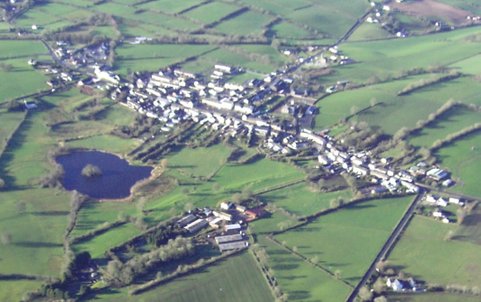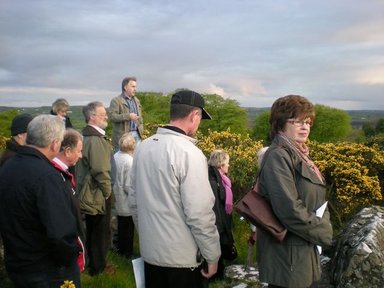Stewartstown and District Local History Society
Co. Tyrone
Northern Ireland
2009 Carrickmore
Carrickmore
Our local outing this year was to Carrickmore (An Tearmann). About twenty members made the journey to this historic village where we met our host Damian Woods. Our first stop was the Women’s Graveyard (Relig na Mban) in the townland of Killeen (cillin- little church) just outside the village. Local tradition states that Colmcille (St Columba ) directed that a woman of ill-repute should be buried at a place where the toll of the monastic church bell could not be heard. However he also directed that devout women buried here would not be denied entry to heaven.
A detailed survey of the site could not be specific on its origins. The most logical explanation is of a community of holy women linked in close proximity to An Tearmann- an early example of a “double monastery”. The last burial took place here c1909.
Next we visited Mullinalap (hill summit of the bed) / An Tearmann (from latin terminus = a boundary, but in Irish also meaning a refuge or sanctuary) situated in the village next to the present Roman Catholic Church. O’Donnell’s “Life of Columba” states that Colmcille came to ‘Termon Cuimnigh’ where he consecrated ground for a monastery. Colmcille was a Northern Ui Neill who by the C6th were expanding southwards from their base in present day Donegal / Derry. Here on Mullinalap, originally a remote rocky outcrop we have a classically remote monastic site, 600 foot above sea-level. On the hill are rock formations known as the saint’s well, bed and chair – all objects which would also have been venerated in the pre-Christian era and fell automatically into a new Christian context.
Dr Reeves, the C19th bishop and antiquarian, also concluded that there was a C6th monastic foundation here, founded either by the saint or his follower Conaed. This may account for the name given to the new C12th parish “Termonconyn”. The original monastic site may be the little half-acre townland in the present graveyard named “Old Church Yard”.
Damian also pointed out the nearby hillside of Dunmisk (Domnach Meascain). A detailed archaeological survey some years ago uncovered a previously unknown site with a church and a burial site of extraordinary complexity. The “Tripartite Life of Patrick” (c 900AD) refers to a lost church of Patrick, “Domnach Meascain” (the Brewer’s Church). This site, in Ui Briuin territory, stood at the junction of an ancient road system linking important Patrician ecclesiastical sites such as Armagh, Donaghmore and Donaghanie. If this is a Patrician foundation, it pre-dates the C6th monastic site at An Tearmann.
This account is based on Damian Woods’ s excellent handout on the history of the village for which the Stewartstown & District Local History Society is grateful.
Tea and sandwiches in the village rounded off a very interesting and historical evening.
Damian Woods talking to members of the Stewartstown Local History Society
On Mullinalap.


